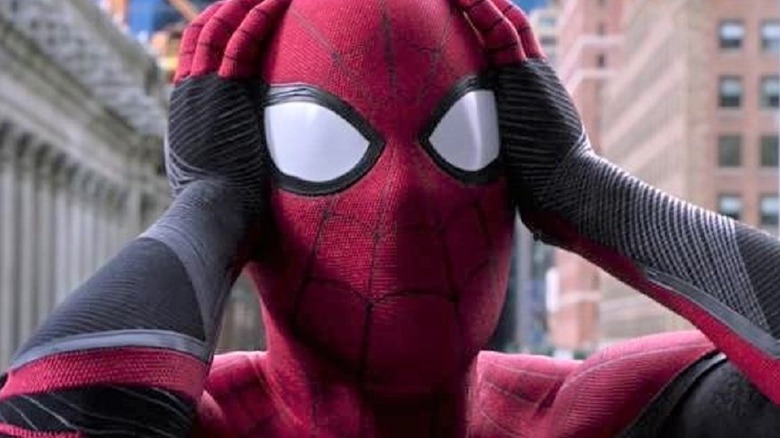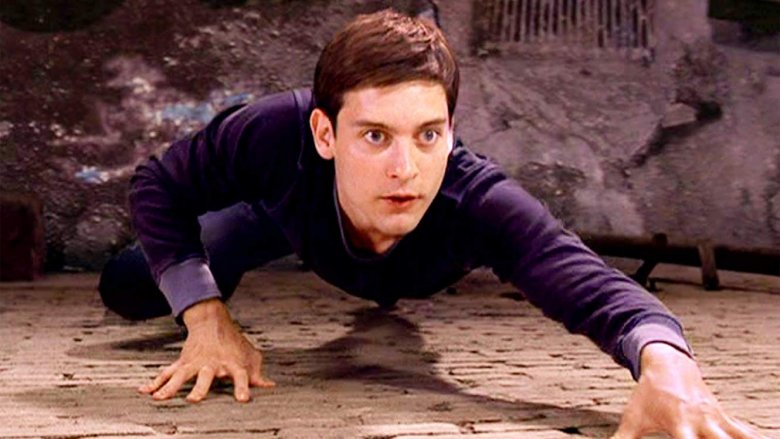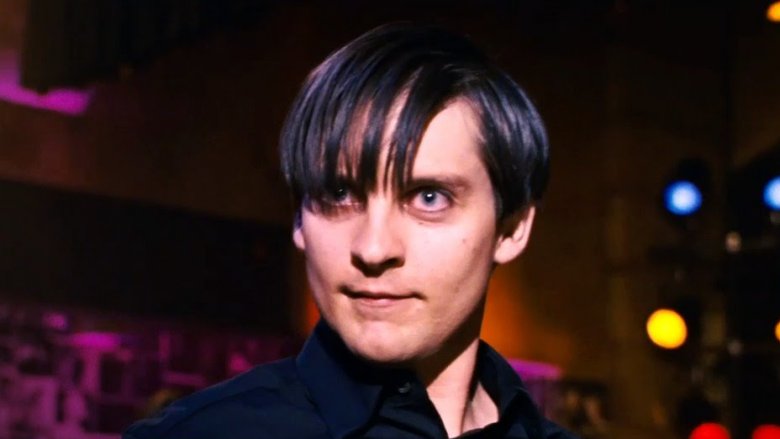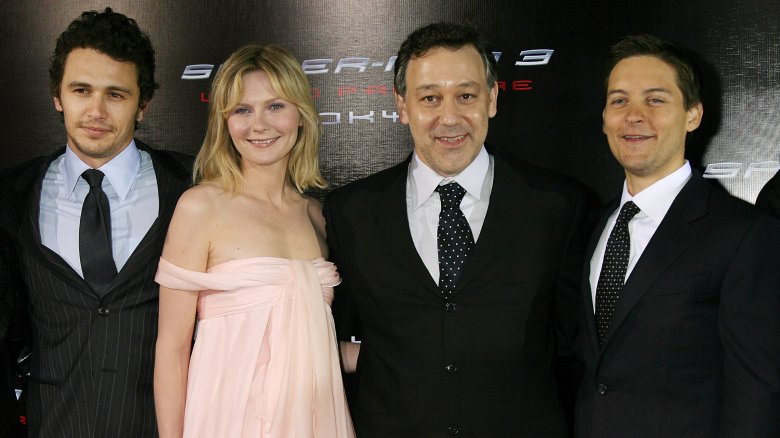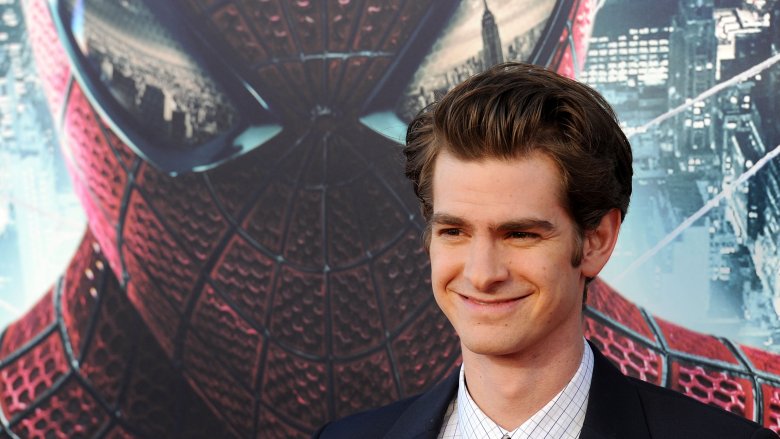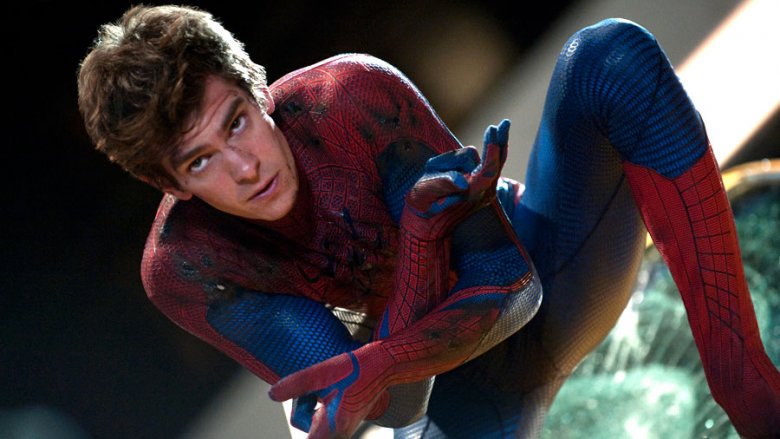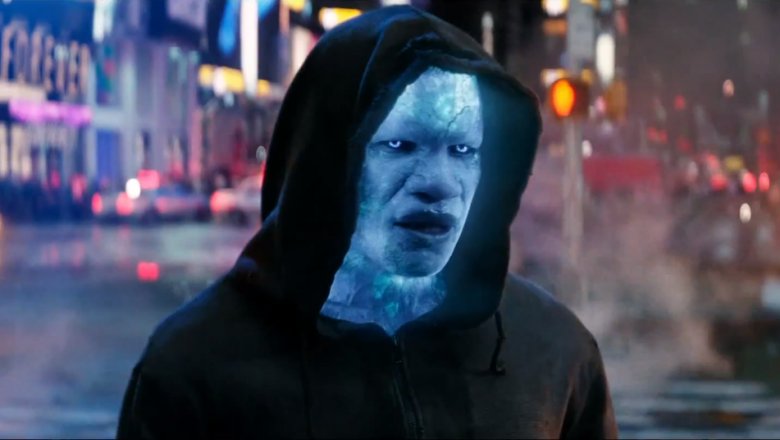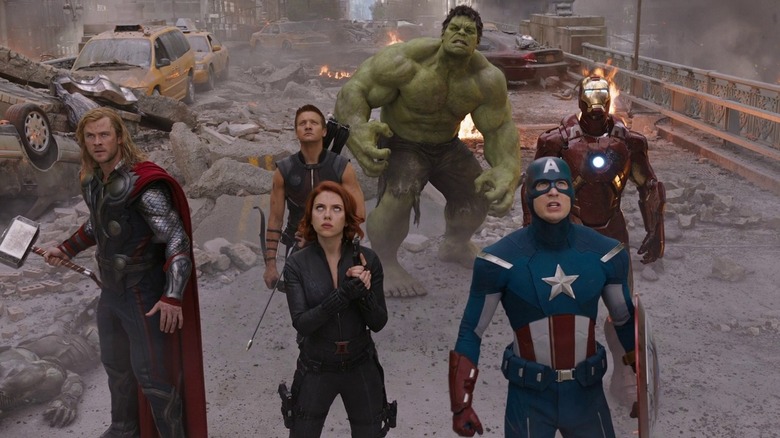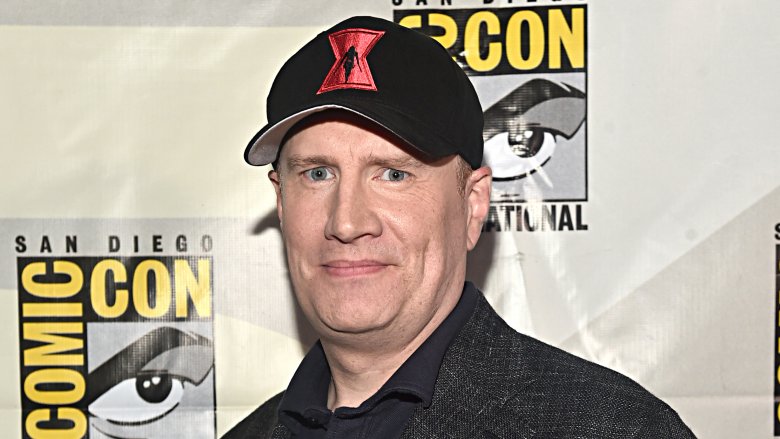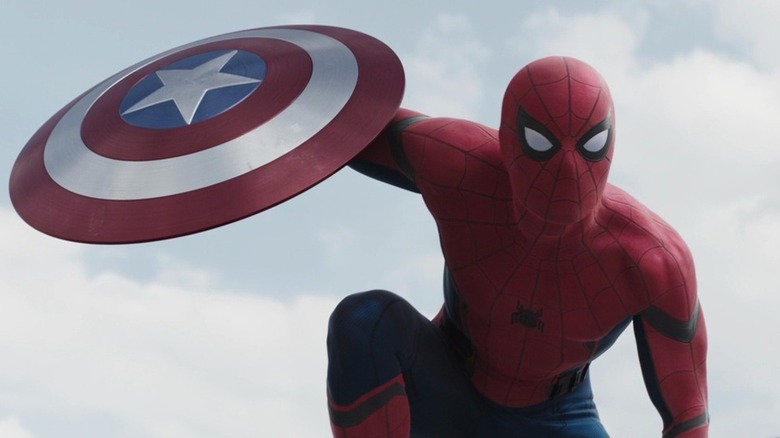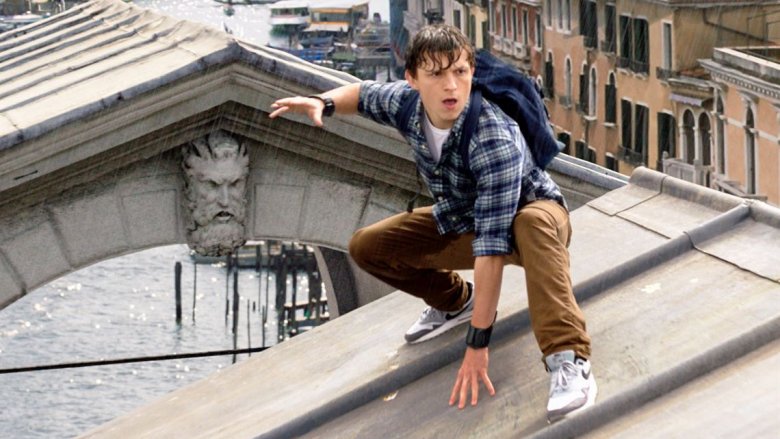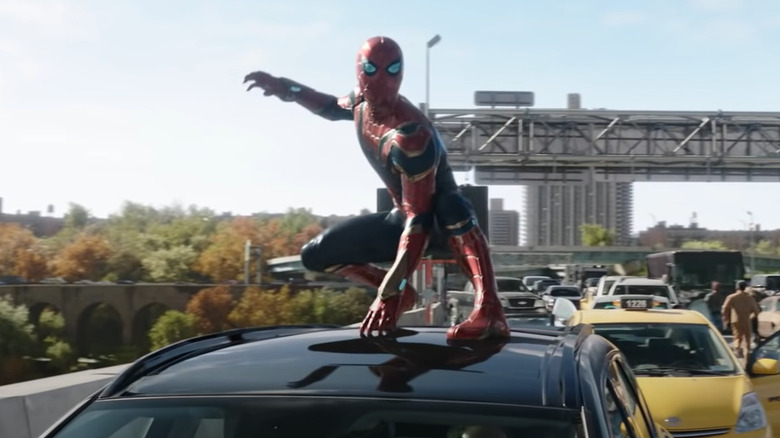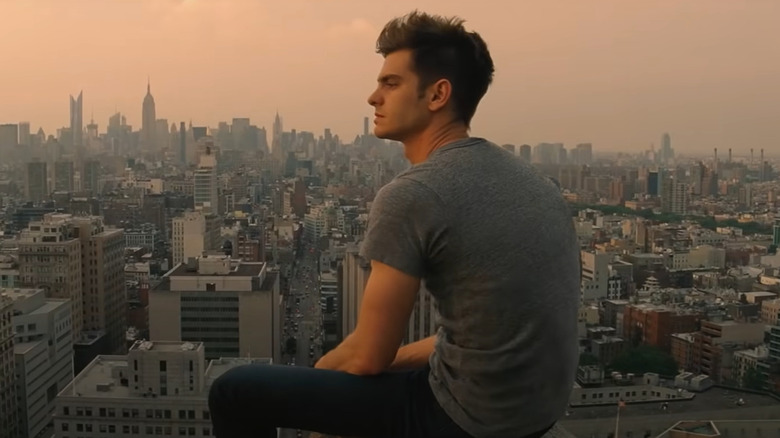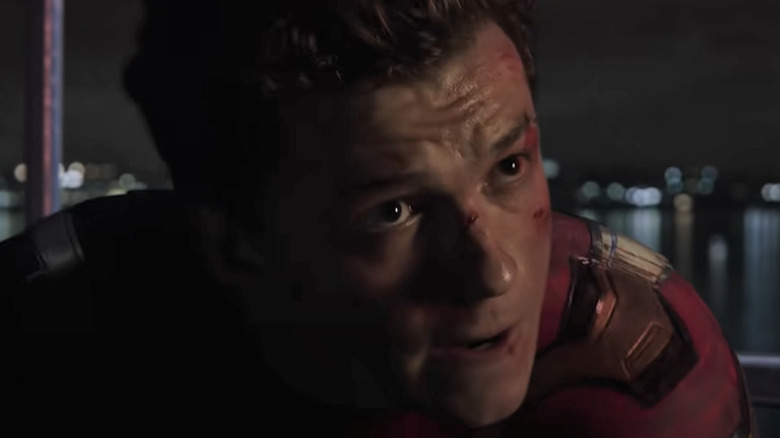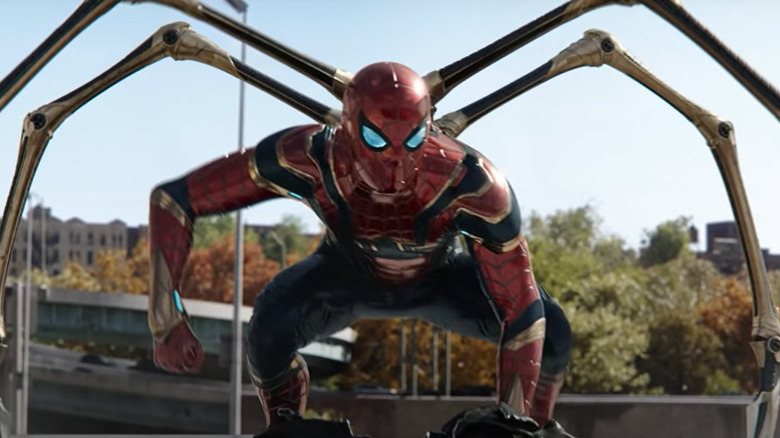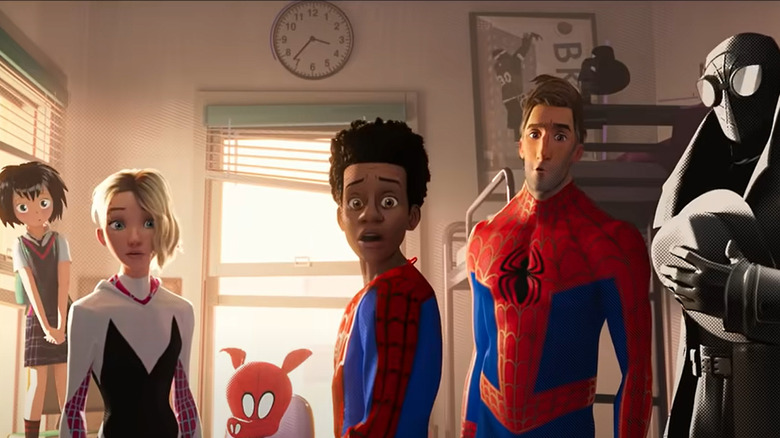The Real Reason We've Had 3 Actors Play Spider-Man In 10 Years
For the most part, successful superhero movie characters are associated with a single actor who plays them for an extended period of time. When you hear "Iron Man," you think Robert Downey Jr. When you hear "Wolverine," you think Hugh Jackman. When you hear Spider-Man, you think Tom Holland ... or Tobey Maguire ... or, if you're really weird, you think Andrew Garfield.
Unlike Iron Man, who was played by the same actor for 11 years, or Wolverine, who had the same man behind the claws for 17 years, Spider-Man is lacking in consistency. In the 10 year period that separated 2007's "Spider-Man 3" and 2017's "Spider-Man: Homecoming," three different actors portrayed the web-slinger. For reference, it took 26 years — from 1987's "Superman IV" to 2013's "Man of Steel" — for three different actors to portray Superman on the big screen. So what makes Spider-Man so hard to nail down?
There are a number of factors that have gone into the never-ending carousel of Spider-Man actors, with most of them coming down to failed films and poor studio decisions. The "Spider-Man" franchise seems to be in a good place now with Tom Holland at the helm, but history tells us that he probably shouldn't get too comfortable in his red spandex. To find out why that is, take a look below at the real reason we've had three actors play Spider-Man in 10 years.
The first Spider-Man actor launches the era of superhero blockbusters
Superhero movies dominate the current Hollywood landscape. But that hasn't always been the case. The modern superhero movie boom owes its creation to 2002's "Spider-Man." Though some may point to 2000's "X-Men" as the start of modern comic book movie mayhem, that film didn't have nearly the cultural impact that "Spider-Man" did, as indicated by its paltry by modern superhero movie standards box office take of $296 million worldwide. "Spider-Man," on the other hand, grossed $821 million at the worldwide box office — a number that would be impressive for a film released even today (for instance, that's more than "Deadpool 2" made in 2018).
In the days before "The Dark Knight" and the MCU, Spider-Man was the biggest thing going in superhero movies. Directed by Sam Raimi and starring Tobey Maguire, the 2000s trilogy of "Spider-Man," "Spider-Man 2," and "Spider-Man 3" kept the genre thriving while it was still in its relative infancy, grossing nearly $2.5 billion combined at the box office. The movies made stars of Maguire and his franchise co-stars, Kirsten Dunst (Mary Jane Watson) and James Franco (Harry Osborn), and "Spider-Man 2" is still considered one of the greatest superhero movies ever made. And yet, despite the trilogy's enormous success and undeniable impact on the film industry, the franchise was rebooted just five years after "Spider-Man 3."
The failure of Spider-Man 3
If you're just looking at the numbers, Spider-Man 3 was a monumental success. It was 2007's highest-grossing film domestically, and it made more money at the box office than either of its predecessors. So why, after making a ton of money, did Spider-Man 3 sound the death knell for the Maguire iteration of the character? Well, to put it simply, the movie had some problems.
Critics were not kind to the film upon its release. Fans, for the most part, were in agreement. It came in for criticism for an overstuffed plot where Spider-Man faced off against three villains — Sandman, Harry's new Green Goblin, and a miscast Topher Grace as Venom. There was also a love triangle with the addition of Gwen Stacy, a retcon of Uncle Ben's death, and Peter Parker's own inner battle after he's infected with the Venom symbiote. That last bit led to some now infamous scenes featuring the meme-able "Emo Peter Parker" dancing in the streets. However, while director Sam Raimi said the film was "awful" in a 2015 interview, it has come in for re-evaluation in some circles.
Spider-Man 4 no more
In spite of the well-documented issues surrounding "Spider-Man 3," the immediate plan from Sony was to continue the franchise with the current team intact. After all, the movie made a boatload of money, and money talks in Hollywood. Raimi began working on "Spider-Man 4" shortly after "Spider-Man 3" bowed, with both Maguire and Dunst ready to return. The director was looking to feature the Vulture as the film's villain, and had even secured John Malkovich for the role. He also nabbed Anne Hathaway to play antiheroine Felicia Hardy — Black Cat in the comics, but in the movie she would've become Vulturess. The film even had a scheduled release date of May 6, 2011, but alas, it never came to be.
The issue was that Raimi, while working with various co-writers, was unable to get the script to a place that satisfied him. He was desperate not to repeat the mistakes he made in "Spider-Man 3," and thus became very particular about how the fourth "Spider-Man" movie should look, saying in 2013 that he'd wanted the film to take the franchise out on a high note. But once the director realized there was no way he would be able to meet Sony's deadline for the film's release date, he told the studio that he no longer wanted to make the film. Rather than trying to find a new director to take over what Raimi had been working on, Sony decided to restart the franchise from scratch, officially ending the original "Spider-Man" series in 2010.
Enter Andrew Garfield, the second Spider-Man actor
Even before Raimi quit working on "Spider-Man 4," Sony already had a contingency plan in place for a reboot film. On the day in 2010 when Sony announced the cancelation of "Spider-Man 4," the studio also announced that a reboot film would arrive in theaters in 2012, and they even already had a script from James Vanderbilt (though this wasn't the script the studio ended up using). Sony's decision to reboot rather than continue with the original cast and a new director came from the studio's belief that the story of Spider-Man was best told through the lens of a boy becoming a man. The reboot would take Peter Parker back to high school, and for this, Sony would need a younger actor than Tobey Maguire, who in 2010 was 35 years old. And after a casting search that included Josh Hutcherson, Jamie Bell, and Alden Ehrenreich, the studio settled on 27-year-old Brit, Andrew Garfield.
While eight years younger than Maguire, Garfield was still at least a decade older than the character he would be portraying, and was two years older than Maguire was in the first "Spider-Man" film. But in spite of Garfield's advanced age, "The Amazing Spider-Man" director Marc Webb felt he was best for the role for a number of reasons. Namely, his chemistry with co-star Emma Stone (Gwen Stacy), his status as a relative unknown, and ... the way he ate a cheeseburger while reading for a scene. Yep, this is going to work out well.
Getting off on the wrong foot
With "The Amazing Spider-Man" reboot hitting theaters just five years after "Spider-Man 3," many were skeptical about how well the film would be received. And as it turns out, that skepticism proved prophetic, as the film underperformed on nearly every level. One heavy criticism was the film's decision to retell Spider-Man's origin story, nearly beat for beat, just a decade after "Spider-Man" did it. By spending much of the running time on a story the audience already knew, the movie wasted its chance to do something new and exciting. Criticism was also leveled at the film over its changes to character and plot. Rather than being an awkward nerd, Garfield's Peter Parker was depicted as being too cool for school. A skateboarder who disrespects authority and cockily stands up to — and even bullies — Flash Thompson, the character simply didn't feel or act like Parker to many fans.
Changes to the story were also criticized. A new plot line was added that made the death of Peter's father part of a vague conspiracy, and it helped drive Peter's motivations. But since Peter still had the traditional motivation of Uncle Ben's death, this additional dead father figure narrative only served to convolute the story.
Ultimately, these story missteps and character changes hurt the film's bottom line. Its worldwide box office gross of $757.9 million, while still an impressive number, was the lowest of the franchise up to that point. But things were about to get worse. A lot worse.
The worst Spider-Man movie yet
"The Amazing Spider-Man," despite its failure to excite the fanbase and its underperformance at the box office, was not a bomb by any means. So, naturally, work quickly began on a sequel. "The Amazing Spider-Man 2" brought in Oscar-winner Jamie Foxx as new villain Electro, but the filmmakers didn't stop there. Seemingly determined to ignore the lessons learned from the overstuffed "Spider-Man 3," the film also added Dane DeHaan as a new Green Goblin, and then there was a tattooed Paul Giamatti performing history's least-convincing Russian accent as the Rhino. The subplot of Richard Parker's death was also featured heavily, with the conspiracy now being tied to Peter's transformation into Spider-Man.
Perhaps the biggest mistake made by the film was the decision to kill Gwen Stacy. While the 1973 comic book story "The Night Gwen Stacy Died" is considered a classic, by the time the film was released in 2014, the plot point of a woman dying to motivate a male character was considered tired at best and offensive and damaging at worst. There was also a strong sense that the character's death was not earned in the film, and that it was done simply because death is what fans associate with Gwen Stacy. These confusing plot choices, as well as some subpar performances (Foxx and Giamatti were especially poorly received) led to both the worst critical reception and the lowest box office take of any "Spider-Man" movie up to that point. Clearly, something had to be done to again save Sony's biggest franchise.
The elephant in the room
At the same time the "Spider-Man" franchise was floundering, the Marvel Cinematic Universe was flourishing. After "Iron Man" kicked off the MCU in 2008, and especially following the monumental success of 2012's "The Avengers," the franchise redefined what audiences expected out of superhero movies. No longer would fans tolerate lazy, by-the-numbers superhero flicks like they had before. Now, superhero movies were expected by fans to be good, and they were expected by studios to make an amount of money that few films had ever achieved before. With Marvel's supposedly B-list heroes like Captain America and Guardians of the Galaxy having their 2014 films earn more money at the box office than "The Amazing Spider-Man 2," the MCU was becoming too big for Sony to ignore.
On the other side of the coin, Marvel was also desperate to bring Spider-Man into the fold. Their films were undeniably successful, but that success was built on the backs of traditionally lesser characters like Iron Man. Since his introduction in 1963, Spider-Man has been the face of Marvel. The belief was that Spider-Man belonged in the MCU with the rest of his Marvel brethren, where the character could then lead the next generation of Marvel films to an even higher level of success. And when major studios are motivated to make a deal, like in this case, sometimes the impossible becomes possible.
A deal is reached
Most industry experts assumed that Spider-Man in the MCU would never happen. Sony owned the film rights to the character, having purchased them long before the MCU came into existence, and he was their biggest cash cow — the jewel in their franchise crown. So why would they ever give him up to Walt Disney Pictures, the owner of Marvel and one of their biggest rivals? The answer is that they didn't give him up — at least not entirely.
After the poor critical and box office performance of "The Amazing Spider-Man 2," Sony decided to pursue another reboot, and given the success of the MCU, they decided to get Marvel Studios to produce the third iteration of Spider-Man in a decade. In February 2015, a deal was reached between Disney and Sony — two major motion picture studios — to effectively share a franchise. Such a deal was practically unheard of, and yet somehow, the studios were able to come up with a plan that left everyone fairly satisfied. Marvel Studios would produce new "Spider-Man" films alongside Sony and also include MCU characters in "Spider-Man" films, but Sony would get full distribution rights for the movies — including all of their box office earnings. So what's in it for Disney/Marvel? They were granted permission to use Spider-Man in their own films, such as "Avengers" movies and were also given all merchandising rights to the character. Now, with both studios wanting what's best for Spidey, it was time for a third Peter Parker to suit up.
The third Spider-Man actor brings the character home
With Marvel Studios on board, it was decided that Spider-Man would debut not in his own reboot film, but rather as part of the huge ensemble in 2016's "Captain America: Civil War." This easing of Spider-Man into the MCU would allow the character to be integrated in the series in a more natural way, while also taking the pressure to carry a film by himself off of the new Spidey. Marvel also decided that the new Peter Parker would once again be a high schooler, but unlike Maguire and Garfield, who were both pushing 30 when they were cast in the role, the studio looked at actual teenagers for the part. And after a highly-publicized search that culminated in a screen test of six teenage actors, 19-year-old British actor Tom Holland was selected as the third live-action Spider-Man.
Holland's version of the character debuted in "Civil War" to rave reviews. By skipping the origin story, fans were instead treated to meeting a Peter Parker who was already fighting crime as Spider-Man. This Spidey was less driven by the guilt over his uncle's death and more driven by his desire to please his new mentor, Tony Stark, who gives him a new suit in the film and recruits him to help fight Captain America and the other rogue Avengers. Fans and critics alike loved Holland's personality in the role, while also finding it refreshing that he was actually, for the first time in Spidey history, close in age to the character he was playing.
Good choice, Sony
Two years after his pitch-perfect MCU intro in "Civil War," Holland starred in his first solo film for Sony, "Spider-Man: Homecoming." The movie was the first "Spider-Man" film to be produced by Marvel Studios, and it proved to be a success by every measure. The film had the highest Rotten Tomatoes score of any "Spider-Man" movie since "Spider-Man 2," and it earned a worldwide box office take that was second only to "Spider-Man 3."
Holland followed up that goodwill by appearing in the two largest Marvel movies to date, 2018's "Avengers: Infinity War" and 2019's "Avengers: Endgame." Both movies have already become cultural touchstones, and they rank as the fifth and first highest-grossing films of all time, respectively. Furthermore, Spider-Man's contributions to each film helped raise the character's profile not only in the MCU, but to the moviegoing public as well. So when the next "Spider-Man" movie debuted less than ten weeks after the premiere of "Endgame," it did so on a wave of MCU-driven excitement and anticipation.
The film's "Endgame" connections proved to be huge, as it was the first MCU movie to take place after the momentous events of that film. "Far from Home" earned stellar reviews, becoming the third "Spider-Man" movie to earn at least a 90 percent average on Rotten Tomatoes. More importantly, the movie obliterated the previous box office record for a "Spider-Man" movie by becoming the first film in the franchise to gross $1 billion at the worldwide box office.
No Way Home affirms the legacy
The third installment of the MCU "Spider-Man" trilogy hit theaters in December 2021 and immediately proved itself a box office titan. Despite the ongoing pandemic and a generally financially anemic box office climate, "Spider-Man: No Way Home" quickly outpaced its two predecessors, making $260 million in its grand debut. That was more than $100 million over its anticipated opening.
No doubt fueling this success was the fans' anticipation of the multiverse. Already confirmed to include villains from both the Raimi and "Amazing" films, rumor had it the movie would also feature all three generations of Spider-Men on-screen at the same time. These were rumors that proved remarkably accurate. Moreover, Tobey Maguire and Andrew Garfield didn't just provide brief cameos. Instead, they were full-fledged co-stars in the film's second half. In addition to providing support to Tom Holland's emotionally distraught Spidey, they revealed aspects of their own lives that had unfolded in the years since viewers last saw them.
Fans thrilled to the webslinging "brothers" meeting and working together to save New York City and all of reality, and thanks to the combined might of Holland, Maguire, and Garfield, "No Way Home" crawled its way into the top 10 highest-grossing films of all time.
Andrew Garfield: The once and future Spider-Man
While the "Amazing" films are generally considered fair to poor, with the second being especially disliked, Andrew Garfield's performance as Spider-Man has usually been well-regarded. Fans responded to his gift for humor, his humanity on-screen, and his undeniable chemistry with Emma Stone.
To see him back in the webs and given a stronger script and plot to work with in "No Way Home" seemed to affirm this impression. Perhaps the movies were terrible, but the actor was not. From there, the next thought was a natural one: Garfield deserves another chance.
Over 30,000 people have signed a Change.org petition affirming their interest, a response that's pretty impressive. Garfield, for his part, remains open to the possibility as well. He's stated both his interest in future films with the other two Spider-Men, as well as a solo endeavor. Fans driving the buzz don't seem to be looking to replace Tom Holland with Garfield, just giving the latter his own adventure in another part of the multiverse.
Tom Holland would like to rest
Ever since Tom Holland first appeared on-screen as the friendly neighborhood Spider-Man in "Captain America: Civil War," he's appeared in multiple MCU entries, including solo films and "Avengers" movies. He's been beaten up, had his identity revealed, and been turned to ash. So the actor is understandably a bit tired.
From a career standpoint, Holland seems hungry to expand his palette. He has another possible franchise with the film adaptation of the video game "Uncharted." Additionally, he's pursued dark and challenging material in films like "Cherry" and "The Devil All the Time," films that take the actor very far away from his interpretation of Peter Parker.
For his part, Holland has been relatively open about his desires to step away from Spider-Man, at least for a time. In fact, he's indicated he might want to take a hiatus from acting entirely, although rumors of a Fred Astaire biopic undermine that claim a bit. Regardless, it seems like he's ready to put the red and blue suit away for a bit.
Amy Pascal has a different idea
Before "No Way Home" even hit theaters, Sony was already planning Peter Parker's future, with producer Amy Pascal declaring that another Spider-Man trilogy would soon follow. To be clear, Sony isn't sacking Tom Holland or cutting Marvel out. Instead, Pascal explicitly stated that the plan would be for three more Sony-Marvel collaborations starring Holland as the webhead.
Given it's only been a few years since Sony and Marvel nearly severed their Spider-Man agreement, this declaration is a bit surprising. However, when you look at the critical and financial success the "Home" trilogy, it's easy to understand why Pascal, Sony, and Marvel would want to keep the good times swinging.
Where does that leave Holland? Well, a break isn't the same as a breakup, so all parties could be 100% accurate in their claims. Plus, Marvel Studios' commitment to secrecy is legendary. They've been known to cut trailers to mislead rumor hounds and instruct their actors to keep their lips sealed, if not outright lie. Even Holland has grown into the role of skillfully evading questions.
Given there was no confirmation of Andrew Garfield or Tobey Maguire being part of "No Way Home" until they jumped through those portals, who knows? Maybe they're already filming the next MCU Spider-Man film. Probably not, but ... you never know.
Sony finds a way to get more Spider-People
Despite sharing Spider-Man with Marvel Studios, Sony has continued developing their own Spidey-related projects outside of that relationship. Some have successfully reached the finish line, like the two "Venom" films, while others have languished in development hell, such as a film centering on Black Cat and Silver Sable.
But by far the most successful endeavor gave Sony not one, not two, but six Spider-heroes to call their own. It was all thanks to the animated insta-classic "Into the Spider-Verse." Released in 2018, the movie wowed with incredible art, an animation style that mimicked its comic book origins with incredible dynamism, and heart and humor by the bucketful. While not as financially successful as some of its live-action cousins, "Spider-Verse" is widely acknowledged as one of the very best Spider-films, right up alongside the likes of "Spider-Man 2."
Thanks to the success of the first film, Sony greenlit two follow-ups, "Across the Spider-Verse: Part One" and "Part Two," showcasing the dimension-hopping adventures of Miles Morales and Gwen Stacy, alongside the likes of Spider-Man 2099, in worlds featuring all sorts of different animation styles.
